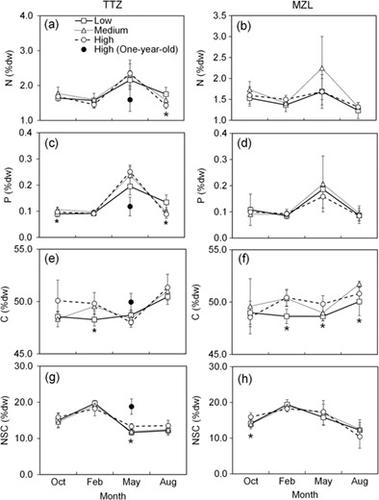当前位置:
X-MOL 学术
›
Ecol. Res.
›
论文详情
Our official English website, www.x-mol.net, welcomes your
feedback! (Note: you will need to create a separate account there.)
Responses of leaf traits to low temperature in an evergreen oak at its upper limit
Ecological Research ( IF 1.7 ) Pub Date : 2020-07-30 , DOI: 10.1111/1440-1703.12157 Xi Jin Zhang 1 , Kun Song 1, 2 , Ying Ji Pan 3 , Zhi Wen Gao 1 , Fa Guang Pu 4 , Jia Hui Lu 1 , Kan Kan Shang 2, 5 , Liang Jun Da 1, 2 , Ellen Cieraad 3
Ecological Research ( IF 1.7 ) Pub Date : 2020-07-30 , DOI: 10.1111/1440-1703.12157 Xi Jin Zhang 1 , Kun Song 1, 2 , Ying Ji Pan 3 , Zhi Wen Gao 1 , Fa Guang Pu 4 , Jia Hui Lu 1 , Kan Kan Shang 2, 5 , Liang Jun Da 1, 2 , Ellen Cieraad 3
Affiliation

|
Low temperature is a major driver of the upper distributional limits of subtropical evergreen broadleaved forests in East Asia. The eco‐physiology of evergreen broadleaved trees at the upper limits could respond to both lower winter temperature and lower averaged annual temperature that covary with elevation. To analyze these responses, we assessed the variations in leaf chemical traits of Cyclobalanopsis gracilis with seasonality and along elevation in the ecotone from subtropical to temperate climate, and analyzed the relationships between traits of mature leaves and temperature. The study showed that the mass‐based nonstructural carbohydrate (NSC) content reached the highest level across elevations during winter; however, the winter NSC content did not differ between elevations. For mature leaves, leaf dry mass per area (LMA) tended to be higher approaching the upper limit. The leaf carbon to phosphorus ratio (C/P) showed an increasing trend with decreasing temperature, as did leaf carbon to nitrogen ratio (C/N) to some extent. The mass‐based P content showed a decreasing trend approaching the upper limit, whereas area‐based P content showed no significant variation. Our main results indicate that leaf NSC content is highest at all elevations in winter, and individuals at high elevations have high LMA and high nutrient use efficiency. The results suggest that for C. gracilis, an increasing leaf NSC results in a baseline protection to cope with cold in winter, which, at higher elevations is supplemented with increasing LMA and nutrient use efficiency to cope with associated low‐temperature stress.
中文翻译:

常绿橡树上限叶片性状对低温的响应
低温是东亚亚热带常绿阔叶林分布上限的主要驱动因素。上限的常绿阔叶树的生态生理学可以响应较低的冬季温度和随海拔升高而变化的较低的年平均温度。为了分析这些反应,我们评估了青冈青冈叶片化学特性的变化。从亚热带到温带气候过渡带的季节性和沿海拔的变化,分析了成熟叶片性状与温度之间的关系。研究表明,冬季各种海拔地区,以质量为基础的非结构性碳水化合物(NSC)含量达到最高水平。但是,冬季NSC含量在不同海拔之间没有差异。对于成熟的叶片,单位面积的叶片干重(LMA)趋于更高,接近上限。随着温度的降低,叶片碳磷比(C / P)呈增加趋势,叶片碳氮比(C / N)在一定程度上也呈上升趋势。基于质量的磷含量呈下降趋势,接近上限,而基于面积的磷含量无明显变化。我们的主要结果表明,冬季各个海拔高度的叶片NSC含量最高,高海拔地区的人具有较高的LMA和较高的养分利用效率。结果表明C. gracilis,叶片NSC的增加为冬季寒冷应对提供了基线保护,在更高的海拔高度,还增加了LMA和营养素利用效率来应对相关的低温胁迫。
更新日期:2020-09-23
中文翻译:

常绿橡树上限叶片性状对低温的响应
低温是东亚亚热带常绿阔叶林分布上限的主要驱动因素。上限的常绿阔叶树的生态生理学可以响应较低的冬季温度和随海拔升高而变化的较低的年平均温度。为了分析这些反应,我们评估了青冈青冈叶片化学特性的变化。从亚热带到温带气候过渡带的季节性和沿海拔的变化,分析了成熟叶片性状与温度之间的关系。研究表明,冬季各种海拔地区,以质量为基础的非结构性碳水化合物(NSC)含量达到最高水平。但是,冬季NSC含量在不同海拔之间没有差异。对于成熟的叶片,单位面积的叶片干重(LMA)趋于更高,接近上限。随着温度的降低,叶片碳磷比(C / P)呈增加趋势,叶片碳氮比(C / N)在一定程度上也呈上升趋势。基于质量的磷含量呈下降趋势,接近上限,而基于面积的磷含量无明显变化。我们的主要结果表明,冬季各个海拔高度的叶片NSC含量最高,高海拔地区的人具有较高的LMA和较高的养分利用效率。结果表明C. gracilis,叶片NSC的增加为冬季寒冷应对提供了基线保护,在更高的海拔高度,还增加了LMA和营养素利用效率来应对相关的低温胁迫。











































 京公网安备 11010802027423号
京公网安备 11010802027423号